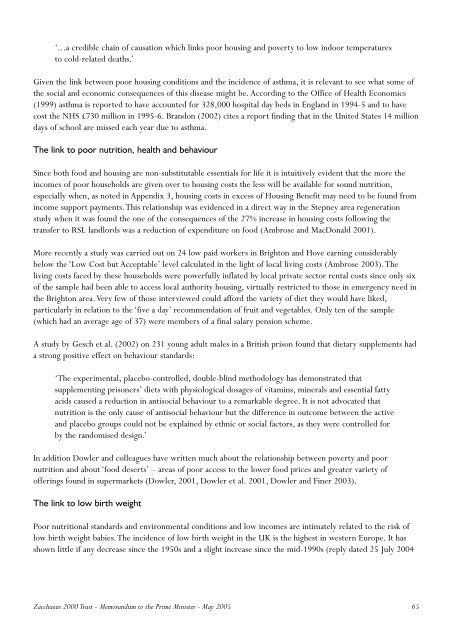Memorandum-to-the-Prime-Minister-on-Unaffordable-Housing
Memorandum-to-the-Prime-Minister-on-Unaffordable-Housing
Memorandum-to-the-Prime-Minister-on-Unaffordable-Housing
Create successful ePaper yourself
Turn your PDF publications into a flip-book with our unique Google optimized e-Paper software.
‘...a credible chain of causati<strong>on</strong> which links poor housing and poverty <str<strong>on</strong>g>to</str<strong>on</strong>g> low indoor temperatures<br />
<str<strong>on</strong>g>to</str<strong>on</strong>g> cold-related deaths.’<br />
Given <str<strong>on</strong>g>the</str<strong>on</strong>g> link between poor housing c<strong>on</strong>diti<strong>on</strong>s and <str<strong>on</strong>g>the</str<strong>on</strong>g> incidence of asthma, it is relevant <str<strong>on</strong>g>to</str<strong>on</strong>g> see what some of<br />
<str<strong>on</strong>g>the</str<strong>on</strong>g> social and ec<strong>on</strong>omic c<strong>on</strong>sequences of this disease might be. According <str<strong>on</strong>g>to</str<strong>on</strong>g> <str<strong>on</strong>g>the</str<strong>on</strong>g> Office of Health Ec<strong>on</strong>omics<br />
(1999) asthma is reported <str<strong>on</strong>g>to</str<strong>on</strong>g> have accounted for 328,000 hospital day beds in England in 1994-5 and <str<strong>on</strong>g>to</str<strong>on</strong>g> have<br />
cost <str<strong>on</strong>g>the</str<strong>on</strong>g> NHS £730 milli<strong>on</strong> in 1995-6. Brand<strong>on</strong> (2002) cites a report finding that in <str<strong>on</strong>g>the</str<strong>on</strong>g> United States 14 milli<strong>on</strong><br />
days of school are missed each year due <str<strong>on</strong>g>to</str<strong>on</strong>g> asthma.<br />
The link <str<strong>on</strong>g>to</str<strong>on</strong>g> poor nutriti<strong>on</strong>, health and behaviour<br />
Since both food and housing are n<strong>on</strong>-substitutable essentials for life it is intuitively evident that <str<strong>on</strong>g>the</str<strong>on</strong>g> more <str<strong>on</strong>g>the</str<strong>on</strong>g><br />
incomes of poor households are given over <str<strong>on</strong>g>to</str<strong>on</strong>g> housing costs <str<strong>on</strong>g>the</str<strong>on</strong>g> less will be available for sound nutriti<strong>on</strong>,<br />
especially when, as noted in Appendix 3, housing costs in excess of <strong>Housing</strong> Benefit may need <str<strong>on</strong>g>to</str<strong>on</strong>g> be found from<br />
income support payments.This relati<strong>on</strong>ship was evidenced in a direct way in <str<strong>on</strong>g>the</str<strong>on</strong>g> Stepney area regenerati<strong>on</strong><br />
study when it was found <str<strong>on</strong>g>the</str<strong>on</strong>g> <strong>on</strong>e of <str<strong>on</strong>g>the</str<strong>on</strong>g> c<strong>on</strong>sequences of <str<strong>on</strong>g>the</str<strong>on</strong>g> 27% increase in housing costs following <str<strong>on</strong>g>the</str<strong>on</strong>g><br />
transfer <str<strong>on</strong>g>to</str<strong>on</strong>g> RSL landlords was a reducti<strong>on</strong> of expenditure <strong>on</strong> food (Ambrose and MacD<strong>on</strong>ald 2001).<br />
More recently a study was carried out <strong>on</strong> 24 low paid workers in Brigh<str<strong>on</strong>g>to</str<strong>on</strong>g>n and Hove earning c<strong>on</strong>siderably<br />
below <str<strong>on</strong>g>the</str<strong>on</strong>g> ‘Low Cost but Acceptable’ level calculated in <str<strong>on</strong>g>the</str<strong>on</strong>g> light of local living costs (Ambrose 2003).The<br />
living costs faced by <str<strong>on</strong>g>the</str<strong>on</strong>g>se households were powerfully inflated by local private sec<str<strong>on</strong>g>to</str<strong>on</strong>g>r rental costs since <strong>on</strong>ly six<br />
of <str<strong>on</strong>g>the</str<strong>on</strong>g> sample had been able <str<strong>on</strong>g>to</str<strong>on</strong>g> access local authority housing, virtually restricted <str<strong>on</strong>g>to</str<strong>on</strong>g> those in emergency need in<br />
<str<strong>on</strong>g>the</str<strong>on</strong>g> Brigh<str<strong>on</strong>g>to</str<strong>on</strong>g>n area.Very few of those interviewed could afford <str<strong>on</strong>g>the</str<strong>on</strong>g> variety of diet <str<strong>on</strong>g>the</str<strong>on</strong>g>y would have liked,<br />
particularly in relati<strong>on</strong> <str<strong>on</strong>g>to</str<strong>on</strong>g> <str<strong>on</strong>g>the</str<strong>on</strong>g> ‘five a day’ recommendati<strong>on</strong> of fruit and vegetables. Only ten of <str<strong>on</strong>g>the</str<strong>on</strong>g> sample<br />
(which had an average age of 37) were members of a final salary pensi<strong>on</strong> scheme.<br />
A study by Gesch et al. (2002) <strong>on</strong> 231 young adult males in a British pris<strong>on</strong> found that dietary supplements had<br />
a str<strong>on</strong>g positive effect <strong>on</strong> behaviour standards:<br />
‘The experimental, placebo-c<strong>on</strong>trolled, double-blind methodology has dem<strong>on</strong>strated that<br />
supplementing pris<strong>on</strong>ers’ diets with physiological dosages of vitamins, minerals and essential fatty<br />
acids caused a reducti<strong>on</strong> in antisocial behaviour <str<strong>on</strong>g>to</str<strong>on</strong>g> a remarkable degree. It is not advocated that<br />
nutriti<strong>on</strong> is <str<strong>on</strong>g>the</str<strong>on</strong>g> <strong>on</strong>ly cause of antisocial behaviour but <str<strong>on</strong>g>the</str<strong>on</strong>g> difference in outcome between <str<strong>on</strong>g>the</str<strong>on</strong>g> active<br />
and placebo groups could not be explained by ethnic or social fac<str<strong>on</strong>g>to</str<strong>on</strong>g>rs, as <str<strong>on</strong>g>the</str<strong>on</strong>g>y were c<strong>on</strong>trolled for<br />
by <str<strong>on</strong>g>the</str<strong>on</strong>g> randomised design.’<br />
In additi<strong>on</strong> Dowler and colleagues have written much about <str<strong>on</strong>g>the</str<strong>on</strong>g> relati<strong>on</strong>ship between poverty and poor<br />
nutriti<strong>on</strong> and about ‘food deserts’ – areas of poor access <str<strong>on</strong>g>to</str<strong>on</strong>g> <str<strong>on</strong>g>the</str<strong>on</strong>g> lower food prices and greater variety of<br />
offerings found in supermarkets (Dowler, 2001, Dowler et al. 2001, Dowler and Finer 2003).<br />
The link <str<strong>on</strong>g>to</str<strong>on</strong>g> low birth weight<br />
Poor nutriti<strong>on</strong>al standards and envir<strong>on</strong>mental c<strong>on</strong>diti<strong>on</strong>s and low incomes are intimately related <str<strong>on</strong>g>to</str<strong>on</strong>g> <str<strong>on</strong>g>the</str<strong>on</strong>g> risk of<br />
low birth weight babies.The incidence of low birth weight in <str<strong>on</strong>g>the</str<strong>on</strong>g> UK is <str<strong>on</strong>g>the</str<strong>on</strong>g> highest in western Europe. It has<br />
shown little if any decrease since <str<strong>on</strong>g>the</str<strong>on</strong>g> 1950s and a slight increase since <str<strong>on</strong>g>the</str<strong>on</strong>g> mid-1990s (reply dated 25 July 2004<br />
Zacchaeus 2000 Trust - <str<strong>on</strong>g>Memorandum</str<strong>on</strong>g> <str<strong>on</strong>g>to</str<strong>on</strong>g> <str<strong>on</strong>g>the</str<strong>on</strong>g> <str<strong>on</strong>g>Prime</str<strong>on</strong>g> <str<strong>on</strong>g>Minister</str<strong>on</strong>g> - May 2005 65




